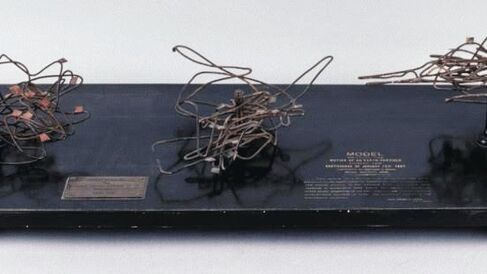A Japanese Earthquake Model

Professor Seikei Sekiya (1855-1896) was a Japanese scientist who was influential in establishing seismology (the study of earthquakes) in Japan. He created a model to represent the motion of the ground during the Tokyo earthquake of 1887.
Sekiya's earthquake model consists of three twisted copper wires that are mounted side by side on a lacquered wooden stand. Each wire shows the path traced out by the motion of an 'earth-particle' during the Japanese earthquake of 15th January 1887 (as recorded at Sekiya's observatory in Tokyo). The horizontal and vertical motion of the ground is magnified 50 times.
Alongside projections, illuminations and glowing gizmos, take part in a trail that follows only the bravest scientists' experiments: those that wanted to try something different...
Drop in family event with buggy parking facilities.
Modelling motion
When designing the model, Sekiya divided the motion so that each of the three wires represents different time periods: the leftmost path is the motion of the particle for the first twenty seconds, the middle path is the motion for the next twenty seconds (Image 1) and the rightmost path is the motion for the following thirty two seconds. Labelled tags on the wires show the particle's position each second, which gives some idea of its speed and acceleration.
Although this model only covers the first 72 seconds, the earthquake motion continued for some time after Sekiya stopped modelling it. As the motion was then occurring in just one plane, Sekiya did not represent it in this 3-dimensional model.
It may not be obvious from the model, but the 'earth-particle' of the title is not a real one. It is a hypothetical particle - a representation of what would happen to a real particle. The motion of the earth-particle was created using the measurements from three separate instruments, each recording a part of the earthquake's motion.
What is the model's purpose?
The standard way of representing earthquake motion at the time Professor Sekiya made the model was the seismogram, and it remains so today. A seismogram is a trace of the earthquake motion made by an instrument called a seismograph. The seismogram simplifies earthquake motion by breaking it down into separate parts. This makes measurement and analysis much easier. Sekiya's model, in contrast, reinforces the complex nature of earthquake motion by showing the movement in three dimensions.
Sekiya says little about the purpose he had in mind for the model. The only clue he gives is his remark that: "looking at the model one will observe the complexities and irregularities of the earthquake motion".(1) This suggests that one purpose for the model is in making the point that earthquake motion is complicated and 3-dimensional.
Sekiya was interested in the vertical part of earthquake motion. The model neatly demonstrates that this type of motion was considerable in a severe earthquake like that of 1887. However, we can also see that vertical motion was much weaker than horizontal motion, as the wire paths cover more area horizontally than vertically.
References
Mark Sprevak
Mark Sprevak, 'A Japanese earthquake model', Explore Whipple Collections, Whipple Museum of the History of Science, University of Cambridge, 2006
